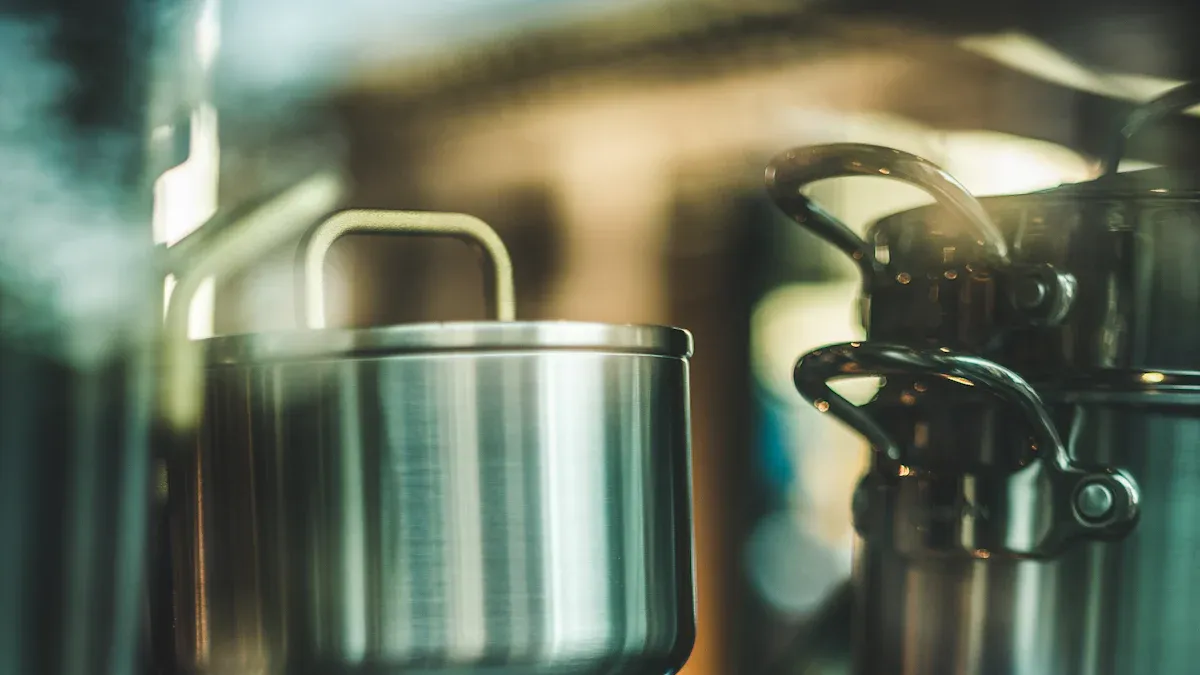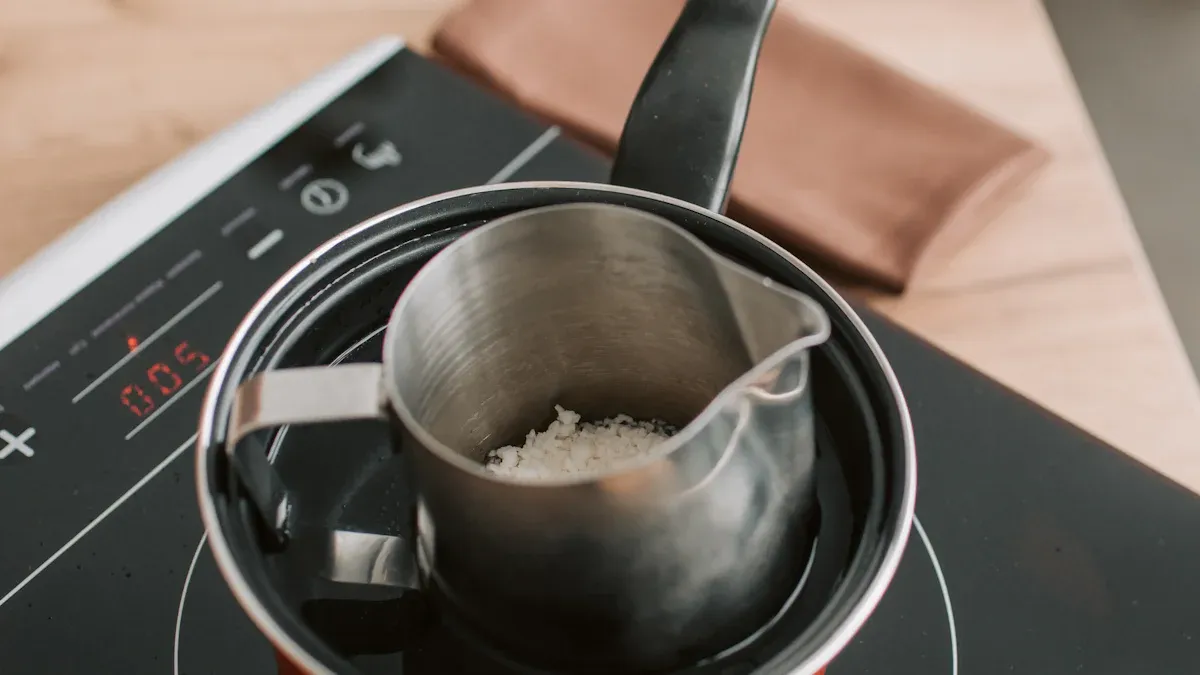How to select pots suitable for induction cooktop

Induction cooktops rely on pots with magnetic properties to generate heat. You can test compatibility by placing a magnet on the cookware's base. Using induction-compatible pots ensures faster heating, precise temperature control, and even cooking. These pots also improve safety since the cooktop surface stays cool, reducing burn risks.
Key Takeaways
Test pots with a magnet. If it sticks, the pot works on induction.
Check for the induction logo on the package. This shows the pot is made for induction stoves.
Pick pots with flat, smooth, and magnetic bottoms. This helps heat spread evenly and cooks food well.
How to test cookware for induction cooktop compatibility
The magnet test: A quick and reliable method
You can easily check for induction compatibility using a simple magnet. Hold the magnet against the bottom of your pot or pan. If the magnet sticks firmly, the cookware is suitable for induction cooking. A weak or no magnetic attraction means the cookware is not compatible. This test works because induction cooktops rely on magnetic fields to generate heat. Only pots with a magnetic base can interact with these fields effectively. Using this method saves time and ensures you avoid purchasing non-compatible cookware.
Identifying induction cooktop cookware symbols
Many manufacturers label their products to indicate compatibility with induction cooktops. Look for symbols like a coil or zigzag pattern on the packaging or the bottom of the cookware. These markings confirm that the item is induction-ready cookware. Checking for these symbols simplifies the selection process and helps you avoid the common mistake of assuming all stainless steel pots work with induction. Remember, only magnetic stainless steel or other ferromagnetic materials will function properly.
Recognizing non-compatible cookware materials
Some materials do not work with induction cooktops because they lack magnetic properties. These include glass, ceramic, non-magnetic stainless steel, and some copper or aluminum pans. Induction cooktops require ferromagnetic materials to generate heat. Without this interaction, the cookware cannot heat up efficiently. Always check for induction compatibility before purchasing new pots to ensure they meet your cooking needs.
Best materials for induction cooktop cookware

Stainless steel: Versatility and performance
Stainless steel is one of the best cookware for induction cooktops due to its durability and versatility. Its multi-layered construction ensures even heat distribution, making it ideal for cooking a variety of dishes. You can use it for soups, stews, or even grilling. Stainless steel is also non-reactive, so it won’t alter the flavor of your food.
Tip: Look for magnetic stainless steel to ensure compatibility with induction cooktops. Some stainless steel pots only have a magnetic base, which may lead to uneven heating.
Feature | Stainless Steel Cookware | Other Materials |
|---|---|---|
Compatibility | May not be compatible | |
Heat Distribution | Multi-layered construction ensures even heating | Often uneven heating |
Durability | Highly durable and non-reactive | Varies by material |
However, lightweight stainless steel pans may vibrate on induction cooktops due to the magnetic field. Choose heavier options for better stability.
Cast iron: Durability and heat retention
Cast iron is another excellent choice for induction cooking. Its magnetic properties make it fully compatible with induction cooktops. It retains heat exceptionally well, which is perfect for slow cooking or frying. Cast iron’s durability ensures it lasts for years with proper care.
To get the best results, preheat your cast iron cookware and match it with the burner size. This improves heat distribution and retention. If you’re worried about scratches, enameled cast iron offers a protective coating while maintaining the same benefits.
Maintenance Tip: Always clean and dry your cast iron pots before use. Avoid sliding them on the induction surface to prevent scratches.
Other options: Carbon steel, enameled cookware, and more
Carbon steel is a lightweight alternative to cast iron. It heats quickly and evenly, making it ideal for stir-frying or searing. Over time, it develops a natural non-stick patina, enhancing its cooking performance. Enameled cookware, on the other hand, combines style with functionality. Its non-reactive surface prevents food from sticking, and its magnetic base ensures compatibility with induction cooktops.
If you’re looking for innovative options, some manufacturers now offer advanced composite materials. These improve heat conduction and durability, giving you more choices for induction-compatible cookware.
Nonstick and aluminum cookware: Special considerations
Nonstick and aluminum pots require special attention when used on induction cooktops. Aluminum lacks magnetic properties, so it won’t work unless it has a magnetic base. Nonstick cookware often includes a ferromagnetic core, making it suitable for induction. However, always check for compatibility before purchasing.
Note: Nonstick coatings can degrade at high temperatures. Use these pots for low to medium heat cooking to extend their lifespan.
By understanding the material options for induction burner pots, you can select cookware that meets your needs while ensuring efficient cooking.
Tips for choosing induction burner pots
Look for the induction symbol on the packaging
When shopping for induction burner pots, always check for the induction symbol. This symbol, often resembling a coil or zigzag pattern, confirms that the cookware is compatible with induction cooktops. Manufacturers include this marking on the packaging or the bottom of the pots and pans. By identifying this symbol, you can avoid the hassle of testing cookware with a magnet or returning non-compatible items. This simple step ensures you select the right pots for your induction cooktop.
Select the right size and shape for your cooktop
The size and shape of your induction burner pots play a crucial role in cooking efficiency. Choose pots with a flat, smooth, and magnetic bottom to ensure proper contact with the cooktop. The diameter of the pot should match the size of the induction burner for even heat distribution. Common sizes like 8-inch, 10-inch, and 3-quart pots work well with most induction cooktops. Refer to the table below for popular sizes:
Size | Frequency |
|---|---|
8" | 30 |
3 qt. | 29 |
10" | 26 |
Selecting the right size prevents energy loss and ensures your food cooks evenly.
Consider reputable brands for quality assurance
Investing in reputable brands guarantees long-term performance and durability. High-quality induction burner pots from trusted manufacturers offer benefits like precise temperature control, even heat distribution, and faster heating times. These features enhance your cooking experience and reduce energy consumption. Additionally, reputable brands often provide warranties, ensuring peace of mind with your purchase. Look for brands known for their sturdy materials and innovative designs to get the best value.
Balance cost and performance for your budget
Induction-compatible cookware varies widely in price. High-end options, like the All-Clad Copper Core 10-Piece Cookware Set, can cost over $1,000. However, you can find affordable alternatives that still deliver excellent performance. Balance your budget by prioritizing essential features like magnetic compatibility, durability, and heat distribution. While premium pots may offer advanced features, mid-range options often meet the needs of everyday cooking. Choose wisely to get the best combination of cost and performance.
Selecting the right pots for your induction cooktop ensures efficient and safe cooking. Magnetic properties are essential for compatibility, so always test your cookware with a magnet or look for the induction symbol. Avoid common mistakes like using uneven-bottomed pots or mismatched sizes. Focus on durable materials, proper sizing, and trusted brands to make the best choice. With this knowledge, finding induction-compatible pots becomes a simple and rewarding process.
Tip: In-person demonstrations or video guides can help you better understand the benefits of induction cookware.
FAQ
What happens if I use non-compatible cookware on an induction cooktop?
Non-compatible cookware won’t heat up on an induction cooktop. The cooktop relies on magnetic fields, so only pots with magnetic bases can generate heat.
Can I use regular stainless steel pots on an induction cooktop?
Not all stainless steel pots work. Check if the base is magnetic by using a magnet. If it sticks, the pot is compatible with induction cooking.
How do I prevent scratches on my induction cooktop?
Use cookware with smooth, flat bottoms. Avoid sliding pots across the surface. For extra protection, consider enameled or coated cookware designed for induction use.
See Also
Essential Advice for Choosing a 2 Burner Induction Cooktop
Comparing Portable Induction Cooktops and Traditional Options
Best Practices for Safe and Efficient Induction Cooking
Exploring the Newest Induction Cooktops Available Today
Determining If a Built-in Induction Cooktop Suits Your Kitchen

